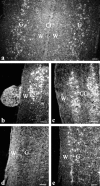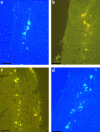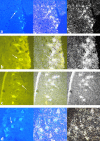Spinal motor and sensory neurons are androgen targets in an acrobatic bird
- PMID: 22635677
- PMCID: PMC5393326
- DOI: 10.1210/en.2012-1313
Spinal motor and sensory neurons are androgen targets in an acrobatic bird
Abstract
Sex steroids affect the motivation to court mates, but less is known about how they influence motor movements associated with courtship behavior. Steroidal control of motor function may be especially important for species in which courtship requires superior strength, stamina, and neuromuscular coordination. Here we use the golden-collared manakin (Manacus vitellinus) to examine whether the neuromuscular circuitry that controls motoric aspects of courtship activity is sensitive to androgens. Males of this tropical species attract mates by rapidly jumping among branches in a courtship arena and using their wings to produce loud wing snaps. Testosterone activates this display via the androgen receptor (AR), and past work reveals that manakins injected with radio-labeled T ((3)H-T) accumulate radioactivity in the spinal cord. Thus, we used quantitative PCR to measure AR, estrogen receptor-α (ER-α) subtype, and aromatase (AROM) mRNA in spinal cords of male and female manakins and zebra finches. Expression of AR, but not ER-α or aromatase, was higher throughout the manakin spinal cord compared with the zebra finch. Next, we tested whether AR-expressing skeletal muscles are innervated by motor and sensory neurons that also express AR. To do this, we backfilled spinal neurons by injecting fluorescent tracers into select AR-sensitive wing and leg muscles of wild caught male and female manakins. We then removed these spinal cords and measured AR expression with in situ hybridization. Both sexes showed abundant AR mRNA in the cervical and lumbosacral spinal enlargements as well as in dorsal root ganglia attached to these enlargements. Together our findings suggest that androgens act widely on peripheral motor and sensory circuits in golden-collared manakins to influence wing snapping displays.
Figures






References
-
- Andersson M. 1994. Sexual selection. Princeton, NJ: Princeton University Press
-
- Adkins-Regan E. 2005. Hormones and animal social behavior. Princeton, NJ: Princeton University Press
-
- Sipos ML , Nyby JG. 1996. Concurent androgenic stimulation of the ventral tegmental area and medial preoptic area: synergistic effects on male-typical reproductive behaviors in house mice. Brain Res 729:29–44 - PubMed
-
- DiMeo AN , Wood RI. 2006. ICV testosterone induces fos in male Syrian hamster brain. Psychoneuroendocrinol 31:237–249 - PubMed
Publication types
MeSH terms
Substances
Grants and funding
LinkOut - more resources
Full Text Sources
Research Materials
Miscellaneous

